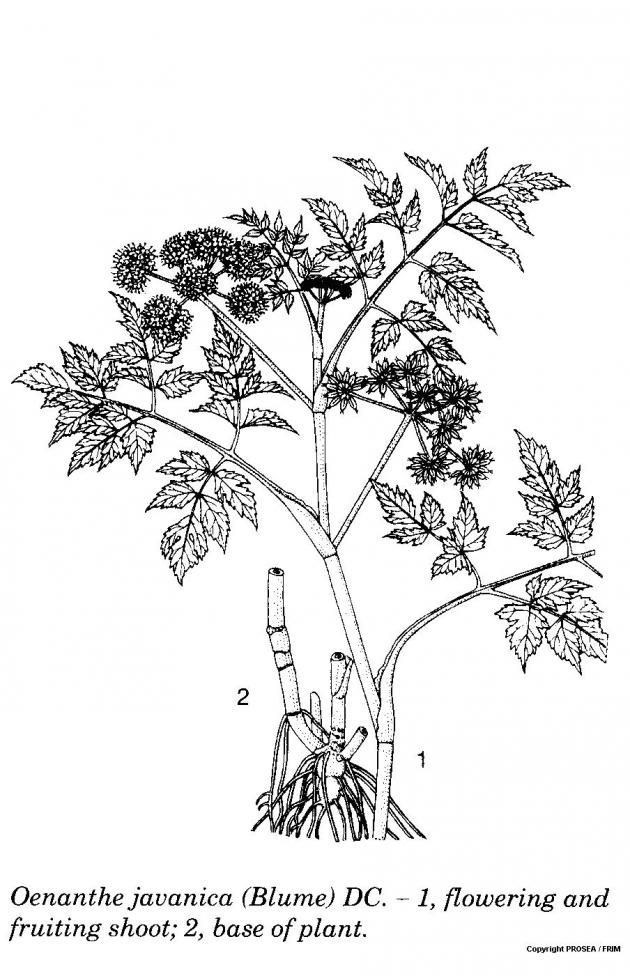Scientific Name
Oenanthe javanica (Blume) DC.
Synonyms
Cyssopetalum javanicum Turcz., Dasyloma corticatum Miq., Dasyloma japonicum Miq., Dasyloma javanicum (Blume) Miq., Dasyloma laciniatum (Blume) Miq., Dasyloma latifolium Lindl., Dasyloma subbipinnatum Miq., Falcaria javanica (Blume) DC., Falcaria laciniata (Blume) DC., Oenanthe decumbens Koso-Pol., Oenanthe kudoi Suzuki & Yamam., Oenanthe normanii F.P. Metcalf, Oenanthe stolonifera Wall. ex DC, Oenanthe subbipinnata (Miq.) Drude, Phellandrium stoloniferum Roxb., Sium javanicum Blume. [1]
Vernacular Name
| Malaysia | Selom, piopo [2] |
| English | Water dropwort, Indian pennywort, water celery [2] |
| China | Shui qin [3] |
| India | Bopo-goli-teng, ujatira [3] |
| Indonesia | Tespong (Sundanese); pampung (Javanese); bacarongi (Sumatra) [2] |
| Thailand | Phakchi-lom (General); phakan (Northern) [2] |
| Laos | S’ii s’aangz (in common with Apium graveolens) [2] |
| Philippines | Ongsoy (Tagalog), alusis (Bontoc), holog (Ifugao) [2] |
| Vietnam | Rau c[aaf]n, rau c[aaf]n n[uw][ows]c [2] |
| France | Persil séri [2] |
| Papua New Guinea | Nase, igundaurautu, takae [2][3] |
Geographical Distributions
Oenanthe javanica is of Asiatic origin and since the ancient times has been widespread in South, Southeast and East Asia, from Pakistan to Japan and Taiwan, and from northern China down to the tropical parts of Australia (Queensland). In most Southeast Asian countries, it is a minor vegetable gathered from the wild or cultivated on a small scale, but it is one of the most common greens in the highlands of Papua New Guinea. [2] O. javanica occurs wild in swampy localities, along streams and in wet grasslands and clearings. It is a cool-season plant, but has wide altitudinal adaptation, occurring from sea level to elevation of 2800 m. It thrives in warm wet areas, although some forms have frost-hardy roots and stolons. [2]
Botanical Description
O. javanica is a member of the Umbelliferae family. It is a perennial, smooth and often aquatic herb. The stems are cylindrical, erect or ascending from a creeping base, hollow, measure 10-100 cm long, much branched and sometimes tinged with red. [2]
The leaves are arranged alternately. The petiole is up to 12 cm long, often sheathing over most of its length and with membranous margins. The leaf-blade is oblong to ovate in outline, measuring 5-30 cm x 5-15 cm and pinnate to tripinnate. The ultimate segments are ovate to narrowly oblong, measuring 0.5-7 cm x 0.3-3.5 cm, with serrate or entire margins, dark green above and dull and lighter coloured with transparent nerves beneath. [2]
The inflorescence is a compound, many-flowered umbel, terminal and opposite the leaves. The peduncle is longitudinally furrowed and measures up to 25 cm long. There are 5-15 primary rays and measure 0.5-3 cm long. The involucres are none or 1. The bracteoles at the base of the umbellules (involucels) are 2-8, linear and green. There are 10-25 secondary rays (pedicels) and measure 2-5 mm long. The flowers are small and white. The sepal teeth are 5 which are distinct, acute, dark green and measure nearly 0.5 mm long. There are 5 obovate petals that measuring up to 2 mm x 1 mm and hairless. The 5 patent stamens are with white filaments, small anthers and yellowish brown. The ovary is hairless. The style is long and persistent. [2]
The fruit is a schizocarp and smooth. The mericarps are 2-3 mm x 0.5-1 mm and with swollen ribs where the marginal ones are much more prominent than the dorsal ones. [2]
Cultivation
No documentation
Chemical Constituent
No documentation
Plant Part Used
No documentation
Traditional Use
No documentation
Preclinical Data
No documentation
Clinical Data
No documentation
Poisonous Management
No documentation
Line Drawing

References
- The Plant List. Ver1.1. Oenanthe javanica (Blume) DC. [homepage on the Internet]. c2013 [updated 2012 Mar 23; cited 2015 July 13]. Available from: http://www.theplantlist.org/tpl1.1/record/kew-2390073
- Sasmitamihardja D. Oenanthe javanica (Blume) DC. In: Siemonsma JS, Piluek K, editors. Plant Resources of South-East Asia No. 8: Vegetables. Wageningen, Netherlands: Pudoc Scientific Publisher, 1993; p. 220-222.
- Quattrocchi U. CRC world dictionary of plant names: Common names, scientific names, eponyms, synonyms, and etymology. Volume IV M-Q. Boca Raton, Florida: CRC Press; 2012. p. 307.


